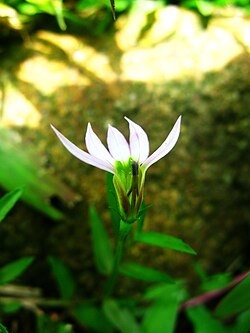Top Qs
Timeline
Chat
Perspective
Lobelia chinensis
Species of flowering plant From Wikipedia, the free encyclopedia
Remove ads
Lobelia chinensis is a species of flowering plant in the family Campanulaceae.[2][3] It is sometimes referred to by the common names Asian lobelia,[4] Chinese lobelia, and Herba Lobellae Chinensis. It is one of the 50 fundamental herbs used in traditional Chinese medicine, where it has the name (Chinese: 半边莲; pinyin: bàn biān lián).[5]
Remove ads
Description
Lobelia chinensis is a small perennial herb[6] that grows in tangled clumps from 15 centimetres (5.9 in) to 35 centimetres (14 in) long. It has a long, thin, branching stem that is olive green and green-brown crumpled narrow leaves. It has little to no odor and a sweet and pungent taste. When harvesting herbs for medical use, the ones with the greenest stems and yellower roots are preferred.[5]
Remove ads
Distribution
It is native to Bangladesh, Cambodia, China, India, Japan, Korea, Laos, Malaysia, Nepal, Taiwan, Thailand, and Vietnam.[2]
Herbal medicine
Lobelia chinensis is considered one of the 50 fundamental herbs in Chinese herbology. Historically, L. chinensis has been used in herbal medicine to help stop smoking, however the Food and Drug Administration has banned the use of herbs containing lobeline due to its lack of acceptable clinical efficacy data.[7]
Chemical constituents
Lobelia chinensis contains 6,7-dimethoxycoumarin, fraxinol, 5-hydroxy-7-methoxycoumarin, tomentin, 3'-hydroxygenkwanin, apigenin, quercetin, luteolin, linarin, luteolin 3',4'-dimethylether-7-O-beta-D-glucoside, isoferulic acid, and ethyl rosmarinate.[8]
Toxicity and adverse effects
Lobelia chinensis is considered mildly toxic[1] due to its adverse effects, including vomiting, heartburn, anxiety, vibrating, eclampsia, increased heart-rate, and severe stomach aches.[9]
References
Wikiwand - on
Seamless Wikipedia browsing. On steroids.
Remove ads

